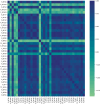AI tool for predicting MGMT methylation in glioblastoma for clinical decision support in resource limited settings
- PMID: 39543155
- PMCID: PMC11564566
- DOI: 10.1038/s41598-024-78189-6
AI tool for predicting MGMT methylation in glioblastoma for clinical decision support in resource limited settings
Abstract
Glioblastoma is an aggressive brain cancer with a poor prognosis. The O6-methylguanine-DNA methyltransferase (MGMT) gene methylation status is crucial for treatment stratification, yet economic constraints often limit access. This study aims to develop an artificial intelligence (AI) framework for predicting MGMT methylation. Diagnostic magnetic resonance (MR) images in public repositories were used for training. The algorithm created was validated in data from a single institution. All images were segmented according to widely used guidelines for radiotherapy planning and combined with clinical evaluations from neuroradiology experts. Radiomic features and clinical impressions were extracted, tabulated, and used for modeling. Feature selection methods were used to identify relevant phenotypes. A total of 100 patients were used for training and 46 for validation. A total of 343 features were extracted. Eight feature selection methods produced seven independent predictive frameworks. The top-performing ML model was a model post-Least Absolute Shrinkage and Selection Operator (LASSO) feature selection reaching accuracy (ACC) of 0.82, an area under the curve (AUC) of 0.81, a recall of 0.75, and a precision of 0.75. This study demonstrates that integrating clinical and radiotherapy-derived AI-driven phenotypes can predict MGMT methylation. The framework addresses constraints that limit molecular diagnosis access.
© 2024. The Author(s).
Conflict of interest statement
Figures





References
-
- Stupp, R. et al. Radiotherapy plus concomitant and adjuvant temozolomide for glioblastoma. N. Engl. J. Med.352(10), 987–996. 10.1056/NEJMoa043330 (2005). - PubMed
-
- Hegi, M. E. et al. MGMT gene silencing and benefit from temozolomide in glioblastoma. N. Engl. J. Med.352(10), 997–1003. 10.1056/NEJMoa043331 (2005). - PubMed
-
- Marta GN, Moraes FY, Feher O, et al. Social determinants of health and survival on Brazilian patients with glioblastoma: a retrospective analysis of a large populational database. The Lancet Regional Health – Americas 4. Available from: https://www.thelancet.com/journals/lanam/article/PIIS2667-193X(21)00062-.... [Accessed on: 20 Jan 2024]. (2021). - PMC - PubMed
MeSH terms
Substances
LinkOut - more resources
Full Text Sources
Medical
Research Materials

